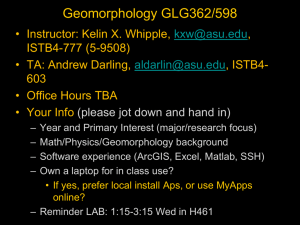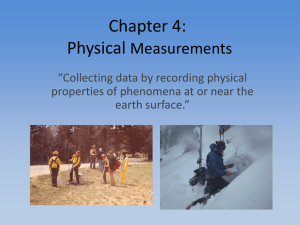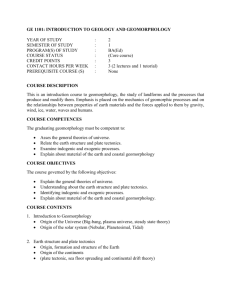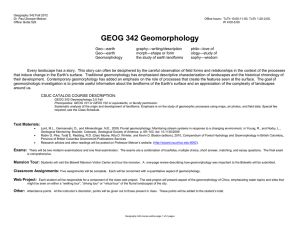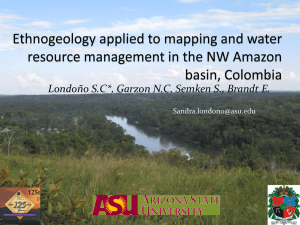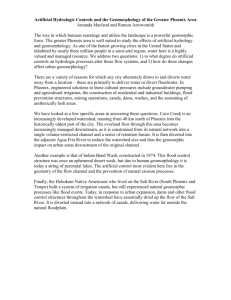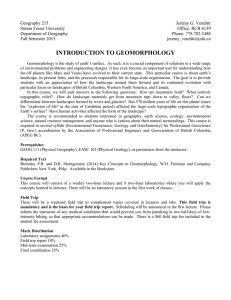Goals of Today’s Lecture Introduction to Geomorphology
advertisement
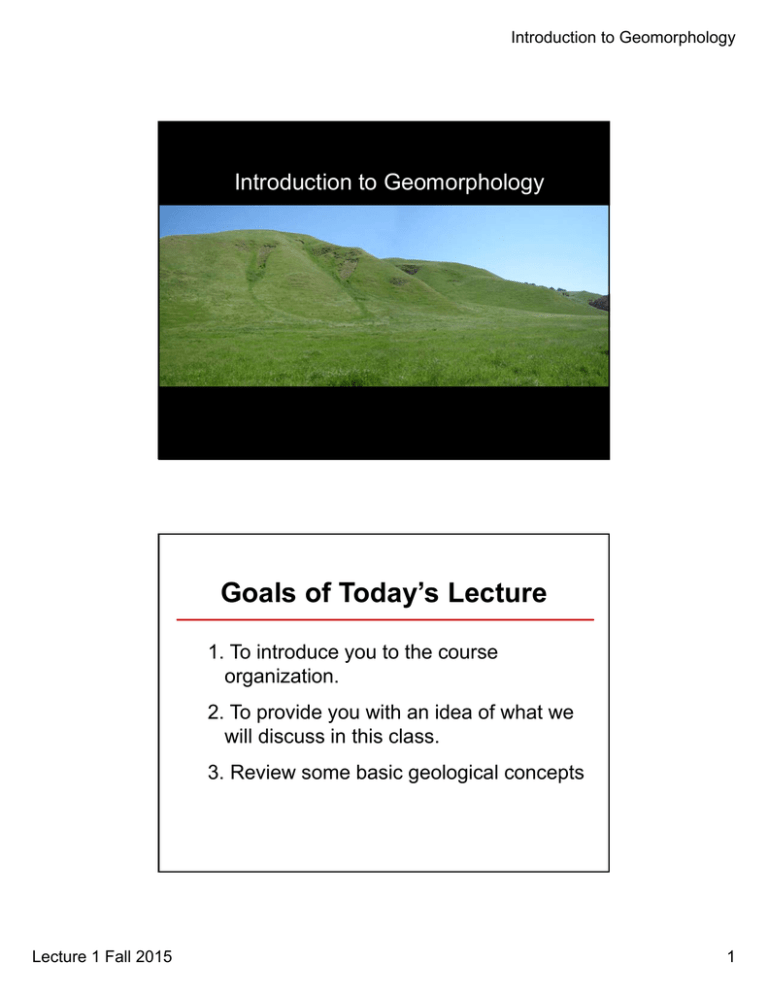
Introduction to Geomorphology Introduction to Geomorphology Goals of Today’s Lecture 1. To introduce you to the course organization. 2. To provide you with an idea of what we will discuss in this class. 3. Review some basic geological concepts Lecture 1 Fall 2015 1 Introduction to Geomorphology Geomorphologist Department of Geography B.Sc. University of Guelph M.Sc. University of Southern California Ph.D. University of British Columbia Post-Doc University of California, Berkeley I am a geomorphologist interested in landscape dynamics and landscape material transport processes. Most of my current research involves sediment transport processes in rivers including sand dune dynamics, gravel transport, and bedrock erosion. Much of the work I do is focused on controlled experiments in laboratories to test hypotheses about landscape dynamics. I have a continued interest in scientifically-based stream restoration (naturalization of streams impacted by landuse practices). Introduction to Geomorphology (GEOG 213) Instructor: Dr. Jeremy G. Venditti Office: 6139 RCB Email: jeremy_venditti@sfu.ca Office hours: Mon 12:30 - 14:30 Teaching Assistant: Dan Haught Office: xxxx RCB Email: drh7@sfu.ca Office hour: Mon 10:30 - 11:30 (Plus one additional hour by appointment on the day office hours are scheduled. Consult with TA on times available at each lab session. TA only hold office hours in weeks before a lab exercise or the field trip report is due.) Lecture 1 Fall 2015 2 Introduction to Geomorphology The Course Format Lectures: Mon 14:30 - 16:20 AQ 5016 Labs: Mon 16:30 - 18:20 Tues 8:30 - 10:20 Tues 10:30 - 12:20 RCB 7108 RCB 7108 RCB 7108 There is no lab fee The Readings Required Texts Bierman, P.R. and D.R. Montgomery (2014) Key Concepts in Geomorphology, W.H. Freeman and Company Publishers New York, 494p. Available in Bookstore Lecture 1 Fall 2015 This is a good introductory textbook. It is the second time we have used it. It is available in the library. 3 Introduction to Geomorphology The Readings Required Scholarly Articles (4): Suggested further readings: Important works that expand on topics covered in class The website Readings and lecture materials can be found at my website: http://www.sfu.ca/~jvenditt/ Lecture 1 Fall 2015 4 Introduction to Geomorphology The Laboratories Labs begin on September 21-22. There are 8 laboratory exercises/assignments. See ‘Tentative Lecture and Laboratory Exercise Schedule’ for due dates and return dates. Late labs will be penalized 1 grade per day. You may contact myself or the TA regarding lab exercise content, but the TA is better suited to deal with specific questions. The Resource Office The Geography Department has a Resource Office where you can go outside of lab hours to use airphotos and maps. Location: RCB 6209 / 6210 Hours: 8:30 – 12:00 and 13:00 – 16:30 The Resource office staff is not there to provide help with the lab exercises. Please see the TA for that kind of guidance. Lecture 1 Fall 2015 5 Introduction to Geomorphology The Field Trip There will be a mandatory weekend field trip to complement topics covered in lectures and labs. CACHE CREEK FIELD TRIP (Tentative schedule) We leave SFU (from Security) at 8.30 am on Saturday, November 7, 2015 and return to SFU around 17.30 to 18.30 pm on Sunday, November 8, 2015. The Grading Laboratory assignments Field trip report Mid-term examination Final examination 40% 10% 25% 25% Important dates 1. MIDTERM: 14:30-16:20, Mon, Nov 2, 2015 2. Field trip report due: 14:30, Fri, Nov 30, 2015 3. FINAL EXAM: 15:30 - 18:30, Sun Dec. 9, 2015 Lecture 1 Fall 2015 6 Introduction to Geomorphology The Course Content Geomorphology is the study of Earth’s surface and the processes that form it. As such, it is a crucial component of solutions to a wide range of environmental problems and engineering designs. It has even become an important tool for understanding how far-off planets like Mars and Venus have evolved to their current state. This particular course is about Earth’s landscape, its present form, and the processes responsible for its large-scale organization. The goal is to provide students with an appreciation of how the landscape around them formed and its continued evolution with particular focus on landscapes of British Columbia, Western North America, and Canada. Our object of interest at the global scale http://www.ngdc.noaa.gov/mgg/image/globalimages.html Lecture 1 Fall 2015 7 Introduction to Geomorphology Our object of interest at the continental scale In this course we will focus on Western NA, Canada, BC Why does earth’s surface look like this? Our object of interest at the local scale Lecture 1 Fall 2015 8 Introduction to Geomorphology Our object of interest at the local scale Flooding happens at the at local scale Pachena River at base flow April, 2008 The local scale is where the change is most obvious and relevant. Lecture 1 Fall 2015 9 Introduction to Geomorphology Flooding happens at the at local scale Pachena River April 28, 2008 @ 2pm The local scale is where the change is most obvious and relevant. Flooding happens at the at local scale Pachena River April 28, 2008 @ 4pm The local scale is where the change is most obvious and relevant. Lecture 1 Fall 2015 10 Introduction to Geomorphology The local scale is where the change is most obvious and relevant. The local scale is where the change is most obvious and relevant. Lecture 1 Fall 2015 11 Introduction to Geomorphology Our object of interest at the grain-scale This scale controls what happens at the larger scales! Questions we will answer in this course Lecture 1 Fall 2015 12 Introduction to Geomorphology 1. What is the fundamental basis of geomorphology? 2. What controls topographic relief? Bill Dietrich Bill Dietrich Marin County, CA Himalayas Lecture 1 Fall 2015 13 Introduction to Geomorphology 3. Where do landscape materials come from? • Weathering, soil production, and bedrock erosion Bill Dietrich David Montgomery 4. How do landscape materials get down from mountain tops to valley floors? D. Montgomery Lecture 1 Fall 2015 14 Introduction to Geomorphology 5. How do landscape materials get from valley floors to their ultimate sink (oceans or lakes) Lena Delta, Siberia David Montgomery 6. How do glaciers modulate landscape development? Barnard Glacier, Alaska Lecture 1 Fall 2015 15 Introduction to Geomorphology 8. Has the emergence of life on this planet affected the large scale topographic organization of the earth? Why Study Geomorphology? • Earth’s surface is our home! http://visibleearth.nasa.gov/ Lecture 1 Fall 2015 16 Introduction to Geomorphology Why Study Geomorphology? • Earth’s surface is our home! • All earth’s organisms rely (in varying degrees) on physical characteristics of earth’s surface as habitat. • Many transport processes (landslides, debris flows, floods, dust stroms) are significant natural hazards Why Study Geomorphology? • Earth’s surface is our home! • All earth’s organisms rely (in varying degrees) on physical characteristics of earth’s surface as its habitat. • Many transport processes (landslides, debris flows, floods, dust storms) are significant natural hazards Lecture 1 Fall 2015 David Montgomery 17 Introduction to Geomorphology Where is this topography? Lecture 1 Fall 2015 18 Introduction to Geomorphology Distributary Fan: "Smoking Gun" Evidence for Persistent Water Flow and Sediment Deposition on Ancient Mars – NASA Press release on 3 November 2003 Lecture 1 Fall 2015 19 Introduction to Geomorphology The end Review of Geological Concepts or things you should know from GEOG 111 or EASC 101 Reading Assignment: You should review the material on the following slides. If you don’t remember some of the material, review you GEOG 111 or EASC 101 textbooks and notes. Lecture 1 Fall 2015 20 Introduction to Geomorphology Review of Geological Concepts or things you should know from GEOG 111 or EASC 101 Rock Materials: We need to understand the basics of rock materials because they contain information about how they were formed. As such, rock materials allow us to estimate the overall history of a site and the rates of geomorphic processes (weathering rates, transport rates, transport distances). Fortunately, knowledge of a few basic minerals is all that is needed to understand how most landscapes develop. Review of Geological Concepts or things you should know from GEOG 111 or EASC 101 Rock Types: 1) Igneous: Form directly from the cooling of magma (e.g. basalt, granite). Lecture 1 Fall 2015 2) Sedimentary: layers of this debris get compacted and cemented together (sandstone, mudstone, limestone, Halite). 3) Metamorphic: Rocks whose minerals have become unstable in their environment and are changed into something new (e.g. slate, schist, gneiss, and marble) 21 Introduction to Geomorphology http://pubs.usgs.gov/imap/i2781/ From Ritter, 2002 Lecture 1 Fall 2015 22 Introduction to Geomorphology The portion of the lithosphere that is of greatest interest to us (i.e. the exposed surface) is largely sedimentary rock overlain by loose sediments. From Ritter, 2002 The Rock Cycle Lecture 1 Fall 2015 23 Introduction to Geomorphology Bowen’s Reaction Series Crystallization temperature First to Crystallize Last to Crystallize Phaneritic Aphanitic (Coarse Grained) (Fine Grained) % Silica Granite Rhyolite Granodiorite Dacite Diorite Andesite Gabbro Basalt Extrusive Intrusive The Classification of Igneous Rocks Peridotite Lecture 1 Fall 2015 24 Introduction to Geomorphology The Classification of Sedimentary Rocks Clastic (Detrital) Sediments Graywacke (Abundant rock fragments, felspar & clay) Shale Cementation (Angular pebbles) Quartz Arenite (Common name for > 50% silt & clay) Conglomerate Sandstone Siltstone Claystone Gravel Sand Silt Clay 2 mm 0.0625 mm Compaction Mudstone Breccia Fissility Arkose (Abundant felspar) 0.0039 mm Nonclastic (Chemical) Sedimentary Rocks Inorganic Biochemical Limestone (calcite) Limestone (calcite) Dolomite Chert Halite Coal Gypsum Lecture 1 Fall 2015 25 Introduction to Geomorphology Classification of Metamorphic Rock (sandstone) Coarse (many sed & igneous) Quartzite Coarse Increasing Metamorphism Gneiss Hornfels Fine Non-Foliated Foliated Quartzite Schist (Phyllite) Gneiss Phyllite Slate (Shale) Fine (slate) (Many sed.) Particle Size Classification Millimeters (mm) Boulders ≥ 256 Cobbles 64 – 256 Gravel (Pebble) Sand Silt Clay Lecture 1 Fall 2015 Microns (µm) 2 – 64 0.064 – 2 64-2000 0.002-0.064 2-64 ≤ 0.002 ≤2 26 Introduction to Geomorphology Boulders (>256 mm) Cobbles (64 - 256 mm) Lecture 1 Fall 2015 27 Introduction to Geomorphology Gravel (2 - 64mm) Sand (0.064 - 2mm) Lecture 1 Fall 2015 28 Introduction to Geomorphology Silt (64 – 2 µm) Clay (<2mm) Lecture 1 Fall 2015 29 Introduction to Geomorphology Grain-size distributions Probability Distribution Function (PDF) Cumulative Distribution Function (CDF) 60 100 90 80 40 Percent Finer Percent Retained 50 30 20 70 60 50 40 30 20 10 10 0 0 0.001 0.01 0.1 1 Grain-size (mm) Lecture 1 Fall 2015 10 100 0.001 0.01 0.1 1 10 100 Grain-size (mm) 30 Introduction to Geomorphology Lecture 1 Fall 2015 31
